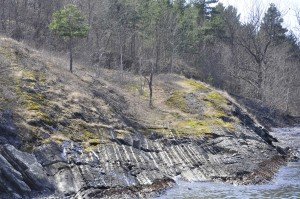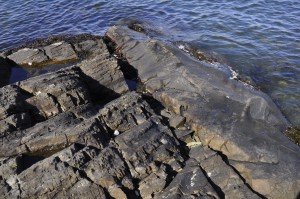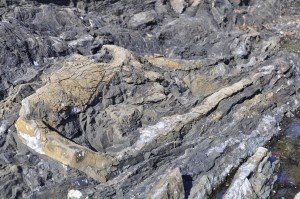For no particular reason, I took a trip to Hovedøya, one of the islands in the fjord just south of Oslo. These islands consist of the ”Cambrosilurian”, Cambrian to Silurian sedimentary rocks that were deposited in a shallow sea on a wide continental margin. Rocks are mostly shale, with sand, limestone, coral reefs and clastic carbonate in between.
In the Caledonian orogeny, when Europe clashed with Greenland/America, they were thrusted and folded into steep dip. Later, the Carboniferous-Permian Oslo rift, quite similar to the African Great Rift Valley, created a graben in which the rocks were preserved. Volcanic rock intrusives from the rift cut through the older sediments in many places.
I still covered just a part of the island, more pictures will follow after the nex trip :)

“Cambrosilurian” shale and chalk nodules, with Oslo city waterfront in the background. Akershus castle to the right, the town hall with the two towers (a.k.a. the big brown cheese) and to the left is Aker Brygge, Oslo’s wannabe-Docklands business quarter.

Steeply dipping sediments, deformed by the Caledonian orogeny. The chalk-rich ground has given the islands in the Oslo fjord a diverse plant life.







Hi Karsten, nice pictures! I notice you use the term chalk nodules, can this be a mistranslation issue? chalk being kritt in norwegian. I believe in this context “kalk” would be more akin to calcareous nodules, even though chalk is also calcareous, the formation of chalk might be slighty different. Happy to be corrected if I’m mistaken :)
Hi! The typically used Norwegian term is “kalkboller”, and their main composition is calcite carbonate. May be “calcite” nodules is a more exact term; we are just used to call them “kalkboller” not “kalsittboller”. :)